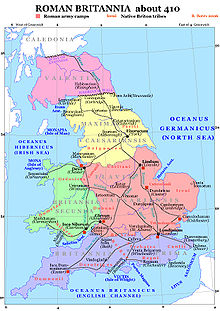- Glevum
-
Coordinates: 51°52′01″N 2°14′56″W / 51.867°N 2.249°W
Glevum (or, more formally, Colonia Nervia Glevensium, or occasionally Glouvia) was a Roman fort in Roman Britain that become "colonia" of retired legionaries in AD 97. Today it is known as Gloucester, located in the English county of Gloucestershire. The name Glevum is taken by many present day businesses in the area and also by the 26-mile Glevum Way,[1] a long-distance footpath or recreational walk encircling modern Gloucester. [1]
Contents
Fortress
Glevum was established around AD 48 as a market centre at an important crossing of the River Severn and near to the Fosse Way one of the important Roman roads in Britain. Initially, there was a Roman fort established at Kingsholm. Twenty years later, a larger replacement fortress was built on slightly higher ground nearby, centred on Gloucester Cross, and a civilian settlement grew around it. The Roman Legion based here was the Legio II Augusta as they prepared to invade Roman Wales between 66 and 74 AD, later being based at Burrium (Usk) and Isca Augusta (Caerleon) in South Wales.
Colonia
 Glevum was probably the provincial capital of Britannia Secunda (green color) during the fourth century
Glevum was probably the provincial capital of Britannia Secunda (green color) during the fourth century
In AD 97, the whole area was designated a colonia by the Emperor Nerva. A colonia was the residence of retired legionaries and enjoyed the highest status in the Empire. The legionaries were given farmland in the surrounding district and could be called upon as a Roman auxiliary armed force.
A large and impressive administrative basilica and forum market-place was built in the town and there were many fine homes with mosaic floors.
Roman Britain was divided into four provinces in the early 4th century. It is most likely that Glevum, as a colony, became the provincial capital of Britannia Secunda, in the same way that colonies at York and Lincoln became capitals of their respective provinces. There is some evidence that at this time Glevum possessed a mint. [2]At its height, Glevum may have had a population of as many as 10,000 people. All the area around Glevum was intensely romanised in the second and third centuries, with a higher than normal distribution of villas, as a result of its suitability for the traditional intensive Roman farming methods.
Indeed, some of the best roman villas in Britain, like Chedworth villa and Woodchester villa (both famous for their roman mosaics), are in the proximity of Glevum.
Decline
Excavations at the New Market Hall showed that Romano-British occupation of the town may have continued in some form into the sub-Roman period, even if the town's population was greatly reduced. A new portal in the wall was made at the beginning of the sixth century, showing a modest growth of the town after the Battle of Mons Badonicus of 497.
The Anglo-Saxon Chronicle records a King Coinmail (according to the original A-text), who may have come from Gloucester, taking part in the Battle of Dyrham in 577, when the city was conquered by the Anglo-Saxons.
Remains
- Many archaeological artefacts and some in situ walls from Roman Glevum may be seen in the Gloucester City Museum
- The remains of the Roman and medieval East Gate are on display in the East Gate Chamber on Eastgate Street.
- There is a small display in the Royal Bank of Scotland on Roman finds from the site
- Northgate, Southgate, Eastgate and Westgate Streets all follow the line of their original Roman counterparts, although Westgate Street has moved slightly north and Southgate Street now extends through the site of the Roman basilica.
- An equestrian statue of the Emperor Nerva was erected at the entrance to Southgate Street in 2002. It was created by Anthony Stone and paid for by public subscription, following a campaign that started in 1997, the 1900th anniversary of the colonia's foundation.[3]
References
- ^ Glevum Way Summary - the Long Distance Walkers Association
- ^ http://www.gadarg.org.uk/essays/e001.htm The colonia of Glevum
- ^ "The Nerva Statue". gloucester.gov.uk. http://www.gloucester.gov.uk/Freetime/Museums/Monuments/TheNervaStatue.aspx. Retrieved 2010-05-01.[dead link]
External links
- Gloucester City Council Museum & Art Gallery homepage
- Gloucester City Council The Romans AD43-577
- Daily Telegraph 30/04/08 Mass Roman grave found in Gloucester
- Glevum on Roman Britain website
Major towns of Roman Britain Londinium (capital of Britannia Superior) - now London
Eboracum (capital of Britannia Inferior) - now York
Camulodunum (first 'capital' of Roman Britain) - now Colchester
Bannaventa* (Northamptonshire) • Caesaromagus - now Chelmsford • Calleva Atrebatum* (Hampshire) • Corinium Dobunnorum - now Cirencester • Deva Victrix - now Chester • Durovernum Cantiacorum - now Canterbury • Durnovaria - now Dorchester • Glevum - now Gloucester • Isca Augusta - now Caerleon • Isca Dumnoniorum - now Exeter • Isurium Brigantum - now Aldborough • Lactodurum - now Towcester • Lindum Colonia - now Lincoln • Luguvalium - now Carlisle • Moridunum - now Carmarthen • Noviomagus Reginorum - now Chichester • Petuaria - now Brough-on-Humber • Ratae Corieltauvorum - now Leicester • Venta Belgarum - now Winchester • Venta Icenorum* (Norfolk) • Venta Silurum - now Caerwent • Verulamium - now St Albans • Viroconium Cornoviorum* (now Wroxeter in Shropshire)See also: List of Roman place names in Britain * Towns labelled with an asterisk have not grown into a modern UK location (their county is shown instead)Categories:- Gloucester
- History of Gloucestershire
- Archaeological sites in Gloucestershire
- Roman towns and cities in England
- 40s establishments
- Populated places established in the 1st century
Wikimedia Foundation. 2010.


